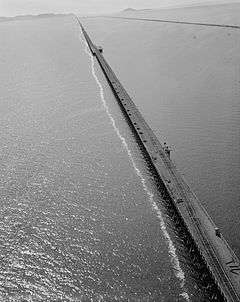Lucin Cutoff
|
Southern Pacific Railroad: Ogden-Lucin Cut-Off Trestle | |
|
Aerial view of the Lucin Cutoff trestle before removal. The 1950s causeway can be seen to the right of the trestle. | |
  | |
| Nearest city | Ogden, Utah |
|---|---|
| Coordinates | 41°13′0″N 112°41′40″W / 41.21667°N 112.69444°WCoordinates: 41°13′0″N 112°41′40″W / 41.21667°N 112.69444°W |
| Area | 143 acres (58 ha) |
| Built | 1902–1904 |
| Architect | William Hood |
| NRHP Reference # | [1] |
| Added to NRHP | April 14, 1972 |
The Lucin Cutoff is a 102-mile (164 km) railroad line in Utah which runs from Ogden to its namesake in Lucin. The most prominent feature of the cutoff was a 12-mile (19 km) long railroad trestle crossing the Great Salt Lake, which was in use from 1904 until the late 1950s.
History
Original Construction
Built by the Southern Pacific Company (SP) between February 1902 and March 1904, the cutoff bypassed the original Central Pacific Railroad route through Promontory Summit where the Golden spike was driven in 1869. By going west across the lake from Ogden to Lucin, it cut off 44 miles (71 km) and also significantly decreased curvature and grades. Built under the direction of SP chief engineer William Hood, a team of 3,000 SP workers worked seven days a week to build the line.
When the line opened, it included short causeways extending from the western shore of the lake and the edge of Promontory Point, connected with a nearly 12-mile (19 km) long wooden trestle. The cutoff also included a causeway which spanned Bear River Bay from the eastern shore of the lake to Promontory Point. This section included a 600-foot-long trestle to allow Bear River water to flow into the lake.
By 1908, five passenger trains and seven freight trains were using the Lucin Cutoff in each direction daily. In 1942, the original line was removed between Lucin and Corinne, Utah — with the last Promontory spikes pulled up and the scrap metal donated to the war effort.[2]
In 1944 the cutoff was the site of a train wreck in which 48 people were killed.
Trestle Replacement
The trestle was replaced in the late 1950s with a parallel dirt and rock causeway built under contract by the Morrison Knudsen construction company. The trestle remained in limited use along side the causeway, until about 1975.[3] The railroad eventually sold salvage rights to the trestle and Cannon Structures, Inc., through its Trestlewood division, began to dismantle it in the early 1990s. Trestlewood continues to market and sell the salvaged trestle wood.[4]
Openings in the Causeway
The causeway would prevent lake water from flowing as freely as the open trestle had, and to help mitigate effects two culverts were included in the original causeway construction. The culverts would allow for a limited amount of water to flow from the lake's southern arm (where surrounding freshwater rivers emptied into the lake) into the lake's northern arm.
In the early 1980s Utah experienced heavy flooding, and much of the extra water along the Wasatch Front flowed into the Great Salt Lake. This resulted in the lake experiencing historic high water levels and flooding nearby landowners. To aid the two culverts in channeling water to the northern arm, the State of Utah constructed a 300-foot-long bridge at the western end of the causeway. The state breached the causeway under the new bridge on August 1, 1984, allowing pent-up water from the southern arm to flow into the northern arm.[5]
The high water levels of the 1980s caused damage to the causeway and required adding more material to raise its height.
In March 2011, Union Pacific Railroad (UP), the successor the Southern Pacific, requested permission to close the two 1950s culverts because of damage related to age and a sinking of the causeway into the lake bed. The two culverts were closed in 2012 and 2013. To mitigate the effects of closing the two culverts, the railroad was required to build a bridge and breach the causeway under that bridge. Construction of a 180-foot-long bridge was completed in fall 2016, although the railroad has agreed to delay opening the breach due to environmental and water level concerns.[6]

References
- ↑ National Park Service (2009-03-13). "National Register Information System". National Register of Historic Places. National Park Service.
- ↑ "Lucin Cutoff Opens - Timeline - Union Pacific 150th Anniversary - UP150.com - Union Pacific 150th Anniversary - UP150.com".
- ↑ Arave, Lynn (December 8, 1993). "Aging Trestle Vanishing From View". Deseret News. Salt Lake City. Retrieved November 26, 2016.
- ↑ "Lucin Cutoff Railroad Trestle: Salvage". Trestlewood. Retrieved November 27, 2016.
The trestle was given new life in the early 1990s. In March of 1993, Cannon Structures, Inc. obtained salvage rights to the trestle from T.C. Taylor Co., Ltd., which had previously acquired these rights from Southern Pacific. Cannon soon thereafter established its Trestlewood Division, through which it has been salvaging, remanufacturing and marketing the wood from the trestle ever since.
- ↑ Bauman, Joseph; Thompson, Jan (August 1, 1984). "Pent-up lake flows into saltier north arm". Deseret News. Salt Lake City. Retrieved November 26, 2016.
- ↑ Penrod, Emma (September 24, 2016). "Union Pacific agrees to delay breach of Great Salt Lake causeway". Salt Lake Tribune. Salt Lake City. Retrieved 26 November 2016.
External links
- Union Pacific Website – Striking a Balance on the Great Salt Lake
- Trestlewood Website – Lucin Cutoff Railroad Trestle
- Mike's Railroad History – Across the Great Salt Lake
- Historic American Engineering Record (HAER) No. UT-13, "Southern Pacific Railroad, Ogden-Lucin Cutoff Trestle, Spanning Great Salt Lake, Brigham City, Box Elder County, UT", 42 photos, 2 color transparencies, 5 measured drawings, 12 data pages, 4 photo caption pages
